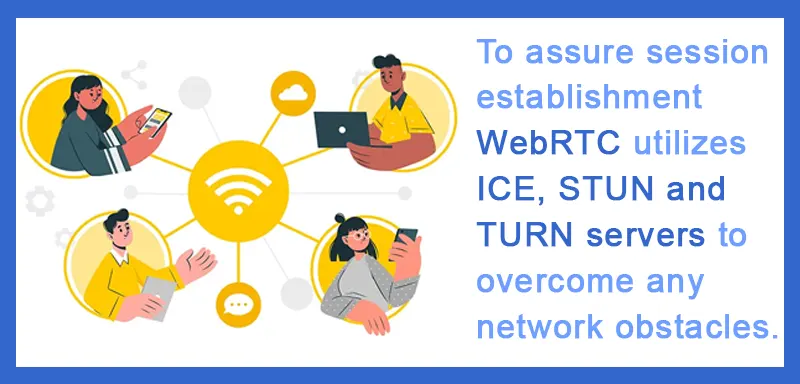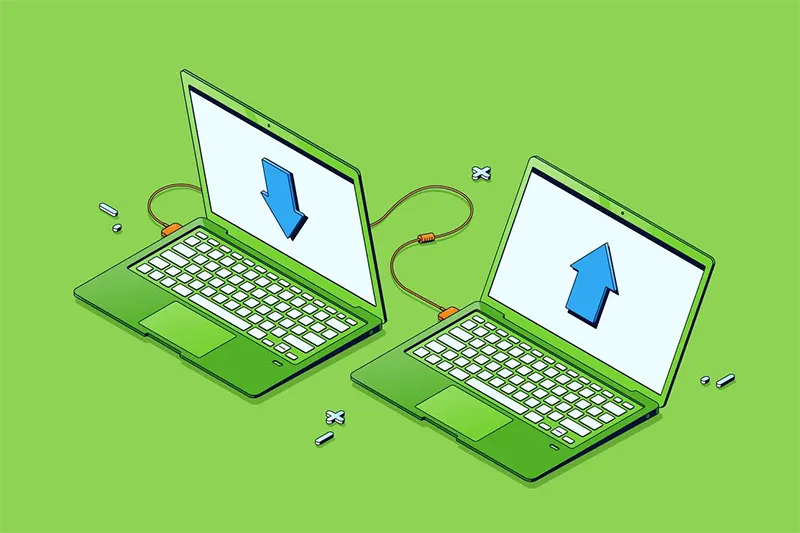Discussing the Future and Top 9 Benefits of WebRTC
There is a lot of talk in the tech world about the upcoming Web2 to Web3 transition. A lot is going to change in terms of technology and how the internet works.
Core functions like communication might also change in terms of how they work. If decentralization picks up as a trend, we might see the demise of big telecom carriers such as AT&T, Sprint and T-Mobile.
Decentralization is a prominent theme in the Web3 scene. Eliminating third parties and allowing for P2P interactions and transactions is not only cost-effective but secure.
Blockchain is the technology driving this change in finance but what about communication? The communication sector has WebRTC.
We’ve had WebRTC since the time Bitcoin was in its early days. While it has proven itself quite capably during the Covid pandemic most are still skeptical about it.
What makes WebRTC the future of communication? Let’s find out!
Top 9 Benefits of using WebRTC
WebRTC is already far superior to its counterparts. Let’s learn about all the benefits that it offers that position it as the future of global communication.
1. Open Source

WebRTC’s core advantage is the fact that it is an open-source solution backed by a strong community of developers.
What does it mean for businesses and innovators?
The technology comes completely free of cost and is updated with the latest features and security updates by the community of developers.
Moreover, being open source means the technology collectively belongs to the community and no one entity can misuse or restrict its use unfairly.
So technically, WebRTC has been decentralized since before decentralization even started trending in the tech scene.
2. Platform and Device Independent

This technology is a combination of three Java Script APIs, viz. Media Stream, Peer Connection and Data Channel.
What does this mean? WebRTC is not only cross-platform compatible but also enjoys cross-device compatibility.
What does this mean for you? You can create a single solution that can work on Mac, Windows, Linux, Chrome OS, etc. You will have the opportunity to make your communication solution capable and intuitive regardless of the device it is used from.
Being platform and device independent, WebRTC can pave the way for truly decentralized communication in the future.
3. Secure Communication

One of the main objectives of WebRTC was to provide a secure means of Peer-to-Peer communication. This is clearly reflected in its framework.
WebRTC uses two protocols internally to secure communications. The first is Datagram Transport Layer Security (DTLS) and the second one is the Secure Real-time Transport Protocol (SRTP).
These two protocols ensure secure communications internally in WebRTC. Signaling isn’t one of the components of WebRTC and developers are free to choose a network protocol they find suitable.
Thus, developers can further consolidate the security of communication via WebRTC by using NTPs such as TLS and TCP.
4. Exceptional Voice and Video Quality

The WebRTC project had stated its objectives when the project was introduced. Along with secure P2P communication, providing exceptional voice and video quality to users was another important objective.
It makes use of the Opus audio codec which is well known for its high fidelity audio voice output. The Opus codec is derived from Skype’s SILK codec and delivers high-quality voice even at low bandwidths.
For video, WebRTC uses the VP8 codec developed by On2 Technologies. Similar to Opus, the VP8 video codec delivers exceptional video quality while being light in terms of bandwidth requirements.
Together these two codecs ensure the user experience is far superior compared to other options available in the market.
5. Assured Session Establishment

Peer-to-Peer direct communication can run into a lot of problems. Generally, the main hindrance can be when the two peers trying to connect are on different network protocols, restricted by their local network, or behind strict firewalls.
Usually, with other pieces of technology, it wouldn’t be possible to establish a communication session under such circumstances.
However, there are functionalities built into WebRTC to ensure you can always establish a communication session regardless of the network situation faced by the peers.
To accomplish this, WebRTC utilizes ICE, STUN and TURN servers to overcome the above-mentioned difficulties.
Thus, a direct line of communication can always be established between peers using WebRTC.
6. VoIP and Video Interoperability

Perhaps the biggest upside of WebRTC is its ability to be interoperable with other voice and video technologies.
A technology developed for and operating on the Internet, WebRTC can not only interoperate with SIP, Jingles and XMPP but also with the traditional PSTN.
This means you will not be restricted in any way in terms of communication capability. Moreover, as legacy telecom infrastructure is transitioning to digital, the coming years will only widen WebRTC’s reach in terms of its ability to interoperate.
Thus, it is fair to say that not only is WebRTC future-proof but can even turn into a universal standard for voice and video communication.
7. Network Condition Adaptiveness

The internet network can experience changes in terms of available bandwidth, network congestion levels, latency, etc. Most communication solutions cannot adjust to such network changes.
WebRTC is capable of adjusting to changing network conditions. There are two core components that allow it to accomplish this.
The first among these is the use of RTP Control Protocol (RTCP) and Secure Audio Video Profile with Feedback (SAVPF).
The second one is its ability to use multiple codecs that correspond to changing network conditions. Codecs can be changed on the fly to ensure the best possible user experience.
8. Rapid Application Development

Two main factors make rapid development of applications based on WebRTC possible. The first is that all the APIs are standardized and the second is that the solution is free to use for commercial and personal usage along with all the required codecs.
This streamlines the development process of any communication application that you may want to develop.
Moreover, there are no costs involved in the acquisition of the solution. So not only is it cost-effective but can be quickly acquired for work to begin.
Another advantage is that WebRTC APIs can be directly plugged into your existing systems to provide communication capability.
This flexibility offered by WebRTC makes it an ideal candidate for communication applications that need to be developed and deployed quickly.
9. Multiple Media Streams for Multi-user Communication

We already elaborated on how WebRTC is a network adaptive communication solution. Another capability that WebRTC has is that it can handle multiple media streams.
This means a single user can communicate with multiple users at the same time. Video conferencing, conference calls, multi-user real-time chats, etc. are possible because of WebRTC’s capability.
Moreover, the users have control over muting audio, stopping video, etc. The moment a user elects to do so, WebRTC stops that media stream.
The user can reinitiate the media stream to restore audio or video while video conferencing. The best part is that all of this can be done without having to leave your browser or install some plugin/extension or application.
With that, you know the top 9 benefits of WebRTC. Let’s top it off by discussing what role it can play in Web3 then, shall we?
Web3 and WebRTC
Before we start, here’s some background on how the telecommunication industry has been so far.
Real-Time Communication isn't something new for the telecom industry. In fact, they spent billions developing hundreds of IP Multimedia Subsystem (IMS) networks.
This investment enabled them to deploy end-to-end, Quality of Service (QoS) controlled Real-Time Communication capabilities.
However, this Unified Communications (UC) network was owned by telcos and inaccessible to a large extent to independent developers, service providers and businesses.
Web on the other hand has been universally accessible to everyone. WebRTC first took to the stage in the Web2 era similar to Blockchain technology. However, both of these technologies are going to play a vital role in the Web3 era.
How is WebRTC relevant to Web3?
WebRTC is what blockchain technology was to the world of global currencies and finance. Its core characteristics reflect the main themes of the Web3 space.
Let’s check these out, shall we?
Peer-to-Peer

WebRTC enables two users to directly connect and communicate with one another. While this still requires them to rely on signaling and other relaying servers, this isn’t similar to the traditional server-client network.
This elimination of a third party’s involvement in the communication sits well with the decentralized nature of Web3.
Secure and Stable

Compared to traditional communications handled by telcos, WebRTC’s peer-to-peer communication is more secure. It uses multiple security protocols internally and if opted then even for the signaling stage.
As the connection and communication are P2P, it is more secure as it eliminates all the security failure points present in a legacy telephony system.
Thus, a high level of security is another tick on the Web3 checklist for WebRTC.
Decentralized and Universally Accessible

WebRTC operates in the Web space utilizing IP. The Web by itself is a universally accessible space. No central or regulatory authority can restrict anyone’s access to it.
WebRTC is a peer-to-peer communication solution. No central authority is required in this instance to enable any form of communication.
Let us also not forget the fact that WebRTC is an open-source technology. It is collectively owned by the people of the internet and the community of developers.
This makes WebRTC truly decentralized and universally accessible which are two of the main themes for Web3.
Ending With
Considering the future and Web3, WebRTC seems to be a perfect fit for it. Not only is it a promising piece of technology but mimics the characteristics of Linux in many ways.
Who knows? WebRTC might end up becoming the backbone of global communication similar to what Linux has been for servers and cloud computing.
What we need for now is for more businesses and developers to pick up WebRTC and develop more solutions and improve on those.
Once we have the ball rolling, innovation will snowball along the way!























































































































